Abstract
Adding domestic waste into cement mortar or replacing fine aggregate can effectively reduce the use of natural sand and gravel and reduce carbon emissions, thereby preventing waste from polluting the Earth’s environment. This study explored a sustainable method for recycling television plastic shell waste (TPSW) by using it as a partial replacement for sand in cement mortar production. By evaluating water–cement ratios (0.4, 0.5, 0.6), ages (3, 7, 28, 56, 91 days), and TPSW levels (0%, 5%, 10%, 15%), this research assessed key properties, such as the slump, compressive strength, and durability. The results show that the TPSW absorbed less water than natural sand, increased the number of pores and slightly reduced the strength. However, a 5% substitution led to a minimal performance loss after 91 days, while it improved the sulfate resistance and resistivity. Overall, incorporating 5% TPSW reduces the environmental impact and carbon emissions, offering a sustainable solution for cement production.
1. Introduction
Faced with depleting global resources, Taiwan, which is surrounded by seas, needs to efficiently utilize resources. In particular, water resources, ecosystems, and air pollution are significant issues [1,2]. Modern society has become a plastic-focused culture, with the use of plastics far surpassing that of other materials, such as ceramics, metals, and glass [3]. Commonly employed plastics in daily life include polyethylene terephthalate (PET), polypropylene (PP), high-density polyethylene (HDPE), low-density polyethylene (LDPE), polystyrene (PS), polyvinyl chloride (PVC), and bioplastic polylactic acid (PLA) [4,5,6,7,8,9]. If household waste plastics could be used as fine aggregate replacements in cement products [10,11,12,13] or incorporated as fiber materials [14,15,16], this would significantly reduce the dependence on natural resources and thereby decrease their consumption. However, current research on incorporating household waste plastics into cement products primarily focuses on the inclusion of expanded polystyrene (EPS) [17,18,19,20,21].
In recent years, technological products have continued to advance, and TVs, as part of daily life, are being updated continuously with technology. Many outdated TVs are being eliminated and becoming domestic waste. How to dispose of domestic waste has become challenging for various countries. There are many TVs that can be broken down at environmental protection stations. During the process of dismantling television waste, particularly the back covers of cathode ray tube (CRT) televisions, large quantities of high-bromine polystyrene (PS) plastic are produced. As the number of CRT televisions being dismantled increases annually, the amount of recovered brominated PS plastic also increases. However, the brominated flame retardants (BFRs) in these plastics degrade slowly in the environment and possess bioaccumulative properties, posing potential environmental hazards [22].
In addition, the external parts of the TV are made of HDPS plastic products, which can be utilized after melt spinning but increase carbon emissions. These materials can be reused before melting to reduce carbon emissions [23,24,25]. The continuous development of TV technology has led to the disposal of outdated TVs in many countries. Civil engineering materials have been oriented toward green renewable resources and sustainable development [26,27,28]. If domestic plastic waste can be added to cement mortar or replace fine aggregates, the use of natural sand can be reduced effectively, and thus, the consumption of natural resources can be reduced. In recent years, the number of discarded TV sets has increased significantly. According to Table 1, due to the rapid changes in science and technology over the past ten years, discarded electronic equipment has become one of the fastest-growing special wastes worldwide [29]. Larger and thinner TV sets have become the main products, and old sets are replaced with new sets, resulting in a large amount of recyclable waste (mainly from factories and residences) [30]. The demand for TVs has increased significantly in recent years, from 1181 tons in 2013 to 30,560 tons in 2022. TVs are divided into internal electronic parts and external TV shells [31]. The TV shells can be processed into recycled plastic pellets by granulation plants and used as recycled plastic materials to implement resource recycling. Previous studies indicated that adding materials with different physical properties to traditional blends has advantages [32,33].

Table 1.
Net resource recovery, Resource Circulation Administration, Ministry of Environment—Recovery Volume Statistics. (unit: kg).
However, these materials must be economically feasible and align with comfort and sustainability criteria [34,35,36]. Some researchers attempted to incorporate such TPSW materials into concrete specimens to replace coarse aggregates [37,38] or partially replace fine aggregates to produce cement mortar, and then analyzed its compressive properties and establishing stress–strain models [39].
Wang, Ru, and Christian Meyer [37] investigated the use of recycled high-impact polystyrene (HIPS) as a sand replacement in cement mortar. Their findings revealed that substituting sand with HIPS led to reductions in both the compressive strength and splitting tensile strength of the mortar, with a notably smaller reduction observed in the splitting tensile strength. The incorporation of HIPS enhanced the ductility of the mortar and increased its energy dissipation capacity. Additionally, the HIPS reduced the dry density, dynamic elastic modulus, thermal conductivity, and water vapor permeability of the mortar, while having no adverse effect on its freeze–thaw resistance. Senthil Kumar, K., and K. Baskar [38] demonstrated that replacing 50% of the coarse aggregate with HIPS aggregate retained 50% of the concrete’s strength under all tested conditions. Their findings also indicated a linear relationship between the strength loss and the increase in the HIPS content. This type of concrete significantly reduces the unit weight of the material, making it suitable for use in earthquake-prone regions and for non-structural components, such as partition walls and lightweight roofing.
Research showed that not all of them are suitable for use as aggregates in concrete. Resin-based types of waste plastic and PET have been reported to have the highest rate of use for concrete production [40,41,42].
Current experimental results show that the mechanical and durability properties of concrete are altered due to the inclusion of plastic. However, such concrete still fulfils the requirements of many engineering applications [43]. In addition, the research results of Alkhrissat, T., indicate that plastic aggregates may be substituted for natural fine aggregates to create an environmentally friendly mortar with similar strength characteristics. [44]. This study used TPSW as a fine aggregate to investigate the fresh properties, engineering properties, and durability of cement mortar made from TPSW with different variables. Their relationships were further established to discuss the influence of different factors (W/C, substitution amount, and age) on the engineering properties of cement mortar.
2. Experimental Design
2.1. Experimental Materials
- Cement: Portland type I cement produced by the Taiwan Cement Corporation was utilized. The image is shown in Figure 1a. Its properties complied with those of ASTM C150 [45], the specific gravity was 3.15, and the fineness was 3450 cm2/g; its physical properties are shown in Table 2.
 Figure 1. Experimental materials.
Figure 1. Experimental materials. Table 2. Physical properties of natural sand and TPSW.
Table 2. Physical properties of natural sand and TPSW. - Fine aggregate: River sand from the Laolong River. The saturated surface dry specific gravity was tested according to the CNS 487 specifications [46]. The saturated surface dry specific gravity was 2.65, and the water absorption was 1.9%. Its appearance is shown in Figure 1b, and its physical properties are shown in Table 2.
- TPSW: The TV shell was made of HIPS and was provided by the manufacturer. The TPSW originally appeared in the form of black flakes. After being crushed by a crusher, the TPSW appeared in the form of a black powder. Its appearance is shown in Figure 1c, and its physical properties are shown in Table 2.
2.2. Test Methods and Items
This study tested cement mortars with different proportions of TPSW, using different substitution amounts (RMs) of 0%, 5%, 10%, and 15% and W/C ratios of 0.4, 0.5, and 0.6 to test its fresh properties (slump and slump flow), and it was transformed into a 50 mm × 50 mm × 50 mm cubic specimen and cured in saturated lime water. Its engineering properties (compressive strength, flexural strength, ultrasonic pulse velocity, and water absorption) and durability (resistivity) were tested at the ages of 3, 7, 28, 56, and 91 days. The proportioning unit weight is shown in Table 3.

Table 3.
Cement mortar proportions with different W/C ratios and TPSW amounts (unit: g/cm3).
The test items and specifications of this study are shown in Table 4.

Table 4.
Test items and specifications.
- (1)
- Slump: according to the ASTM C109 specification, a mini-slump cone was used to conduct a test, and the slump method was used to measure the consistency of the fresh cement mortar to determine the workability of the mortar.
- (2)
- Slump flow: according to the ASTM C230 specification, which mainly measures the standard flow value of the cement mortar.
- (3)
- Setting time: according to the ASTM C403 specification to measure the standard water consumption of cement, the initial setting time and final setting time of the cement were used as a reference for understanding the properties of the cement and concrete construction.
- (4)
- Compressive strength: According to the ASTM C109 specifications, compressive tests were conducted at each age set by the institute to test the pressure-resistant properties of the various cement mortars. The schematic diagram of the testing process is shown in Figure 2.
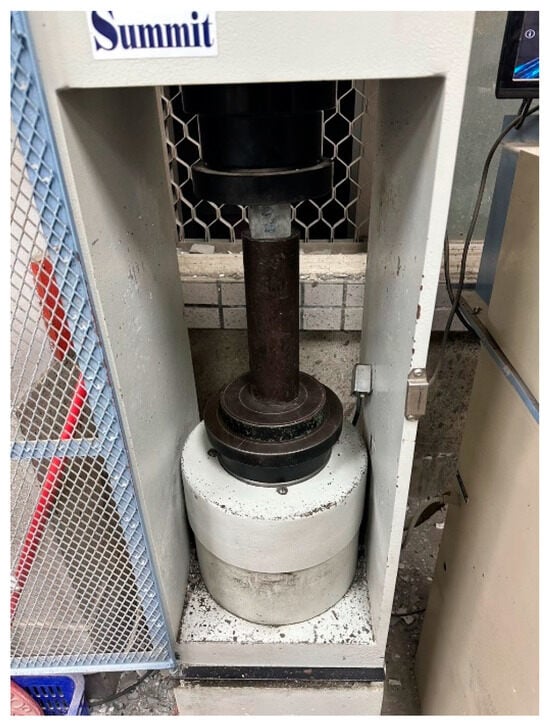 Figure 2. Schematic diagram of the compression test process.
Figure 2. Schematic diagram of the compression test process. - (5)
- Flexural strength: the flexural strength of the standard cement mortar was measured according to the ASTM C348 specifications.
- (6)
- Ultrasonic pulse velocity: The ultrasonic detector used complied with the ASTM C597 specifications and was used to measure the velocity of the ultrasonic waves that passed through the interior of the test object. This process measured the time it took for the ultrasound to travel through the specimen. By analyzing the transmission speed of the ultrasound in the different materials, insights into the internal conditions of the specimens could be obtained. Specifically, this test determined the transmission speed of a vibration energy pulse within the concrete component.
The process began with the pulser, which generated a short-cycle high-voltage signal. This signal caused the transmitter to vibrate at its natural resonant frequency. The transmitter’s vibration pulse was transmitted to the concrete via a coupling fluid and was then received at the other end through the concrete. When the receiver detected the pulse wave, the timing was stopped, and the elapsed time was displayed.
The pulse wave transmission speed in the concrete was calculated by dividing the straight-line path from the transmitter to the receiver by the elapsed time. This speed provided valuable information for estimating the strength and density of the concrete. The schematic diagram of the ultrasonic pulse velocity testing process is shown in Figure 3.
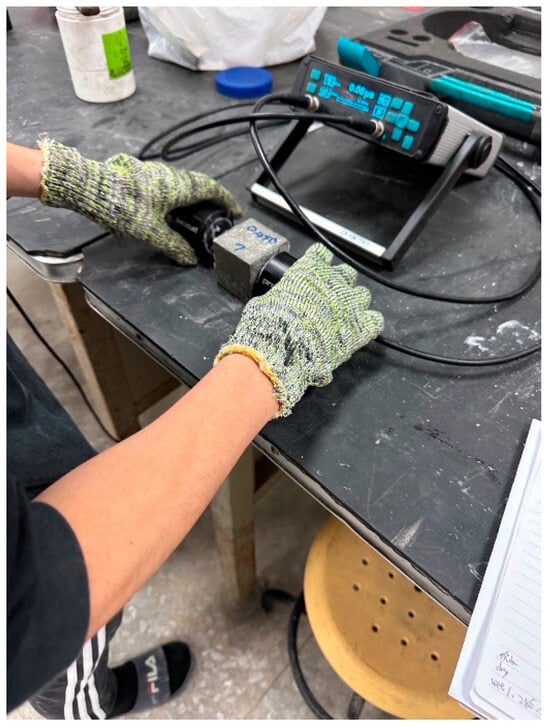
Figure 3.
Schematic diagram of the ultrasonic pulse velocity testing process.
- (1)
- Water absorption: according to the ASTM C1585 specification, the specimen was put through the immersion test, and the water absorption was calculated after measuring the dry and saturated mass.
- (2)
- Resistance to sulfate corrosion: referring to the ASTM C1012 specification, the specimen was soaked in sodium sulfate solution, 5 cycles were performed, the weight loss was observed, and the weight loss rate was calculated.
- (3)
- Resistance: According to the ASTM C876 specification, by measuring the resistance value, when the resistance value was larger, the current flowing through the test object was smaller. The schematic diagram of the resistance testing process is shown in Figure 4.
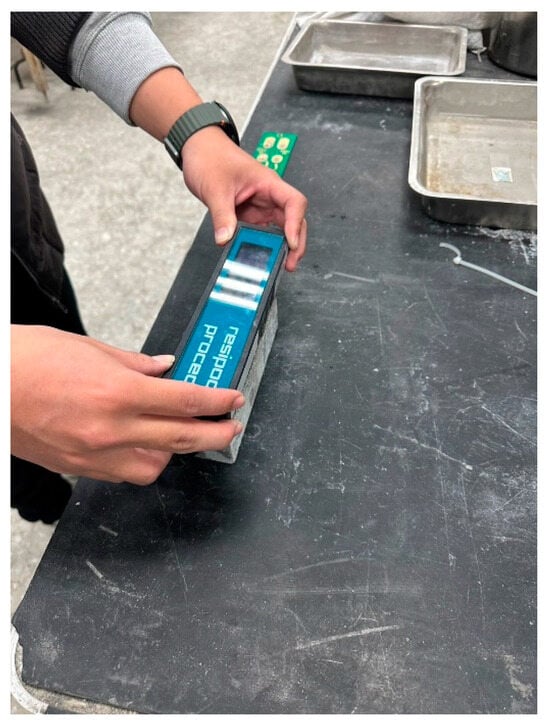 Figure 4. Schematic diagram of the surface resistivity testing process.
Figure 4. Schematic diagram of the surface resistivity testing process.
3. Results and Analysis
3.1. Slump
Figure 5 shows the slump of the cement mortar made by replacing sand with TPSW and that the slump of the control group (0%) was 81.3% lower than that of the 15% TPSW group when the W/C was 0.4. When the W/C increased from 0.4 to 0.5, the slump of the control group was 55% lower than that of the 15% experimental group. When the W/C increased from 0.5 to 0.6, the slump of the control group was 31% lower than that of the 15% experimental group. When the W/C increased, the slump tended to increase because the increase in the water content reduced the cohesion of the paste and increased the slump, and the overall workability and fluidity of the cement mortar increased. Overall, the slump decreased as the amount of TPSW added increased. When the W/C increased, the overall slump increased as the water content increased, so the W/C had a greater impact on the slump than the substitution amount did.
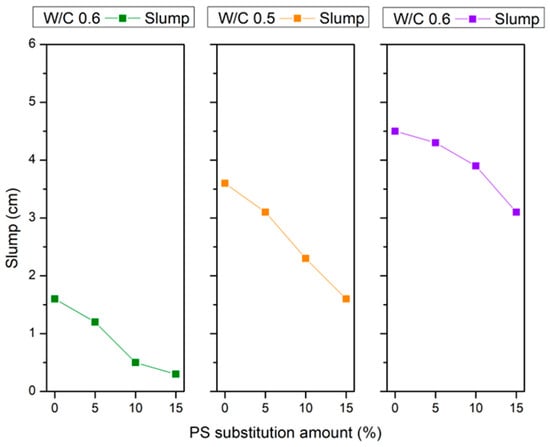
Figure 5.
Slumps of cement mortars with different W/C ratios and TPSW amounts.
As shown in Figure 5, the slump decreased significantly as the proportion of the TPSW materials replacing sand increased. When the water–cement ratio was 0.4, the slumps decreased by 25%, 68.8%, and 81.3% for the substitution amounts of 5%, 10%, and 15%, respectively. For a water–cement ratio of 0.5, the slumps decreased by 13.9%, 36.1%, and 55.6%, respectively. At a water–cement ratio of 0.6, the slumps decreased by 4.4%, 13.3%, and 31.1% for the same substitution levels. These findings are consistent with other studies [38], and the reduction in slump could be attributed to the flaky shape of the TPSW material, which did not perform as well as the coarse aggregate. While increasing the substitution amount reduced the slump, the research results indicate that the water–cement ratio had a greater impact on the slump than the substitution amount.
3.2. Slump Flow
Figure 6 shows a comparison of the slump flow of three W/C cement mortars with partial sand replaced by the TPSW. When the replacement of the TPSW for partial sand was fixed at 5% and the W/C was 0.4, the slump flow was 10.4 cm, and when the W/C increased from 0.4 to 0.5, the slump flow was 19.1 cm. When the W/C increased from 0.5 to 0.6, the slump flow was 23 cm. This research showed that the slump flow decreased as the waste PS substitution amount increased and the overall workability decreased. When the W/C increased, the slump flow of the paste increased with increasing water content. The W/C had a greater impact on the slump flow than the substitution amount did.
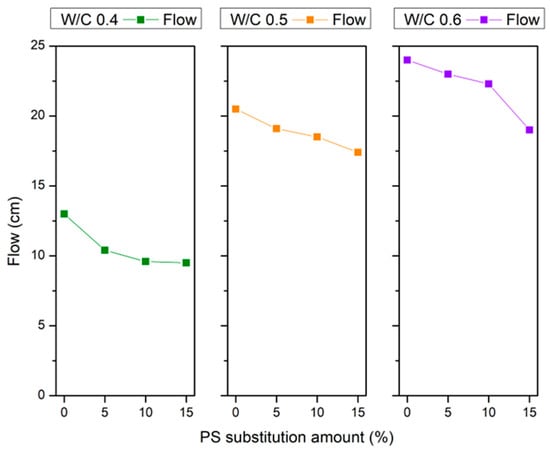
Figure 6.
Slump flows of cement mortars with different TPSW amounts and W/C ratios.
As shown in Figure 6, the slump flow decreased as the proportion of waste PS materials that replaced the sand increased. When the water–cement ratio was 0.4, the slump flow decreased from 13 cm to 9.5 cm; at a water–cement ratio of 0.5, it decreased from 20.5 cm to 17.4 cm; and at a water–cement ratio of 0.6, it dropped from 24 cm to 19 cm. The rough texture of the waste PS materials reduced the slump flow, which led to decreased workability. However, as the water–cement ratio increased, the slump flow improved due to the higher water content. Overall, the water–cement ratio had a greater effect on the slump flow than the substitution amount.
3.3. Setting Time
Figure 7 shows the cement mortar with different TPSW substitution amounts (0%, 5%, 10%, and 15%) and W/C ratios (0.4, 0.5 and 0.6). In the 0% control group, the W/C ratios were 0.4, 0.5, and 0.6, and the initial setting times were 251 min, 341 min, and 448 min, respectively; the final setting times were 598 min, 685 min, and 926 min, respectively. In the 5% TPSW substitution group, the W/C ratios were 0.4, 0.5, and 0.6, and the initial setting times were 238 min, 316 min, and 419 min, respectively; the final setting times were 556 min, 644 min, and 901 min, respectively. In the 10% TPSW substitution group, the W/C ratios were 0.4, 0.5, and 0.6, and the initial setting times were 231 min, 301 min, and 406 min, respectively; the final setting times were 542 min, 626 min, and 885 min, respectively. In the 15% waste PS substitution group, the W/C ratios were 0.4, 0.5, and 0.6, and the initial setting times were 226 min, 292 min, and 397 min, respectively; the final setting times were 509 min, 575 min, and 842 min, respectively. An increase in the overall water content led to partial secretion of the cement paste, while the hydration heat reaction slowed, which prolonged the setting time.
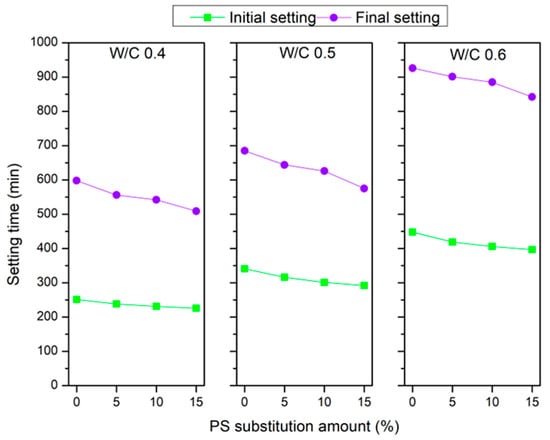
Figure 7.
Setting times of cement mortars with different W/C ratios and TPSW amounts.
The research results also indicate that as the water–cement ratio increased, the setting time increased correspondingly. This occurred because the higher water–cement ratio led to an increased overall water content, which caused the cement slurry to bleed. As a result, the rate of the hydration reaction slowed down, which prolonged the setting time.
3.4. Compressive Strength
Figure 8 shows that when the W/C was fixed at 0.5 and at the age of 91 days, the compressive strength of the control group was 53.2 MPa, the compressive strength of the 5% TPSW substitution group was 48.8 MPa (−8.3%), the compressive strength of the 10% TPSW substitution group was 45.3 MPa (−14.8%), and the compressive strength of the 15% waste PS substitution group was 40.1 MPa (−24.6%). The findings show that as the waste PS had a lower water absorption than the natural sand, there were more water molecules in the specimen, which formed many pores and reduced the compressive strength; when the W/C was 0.5 and at the age of 91 days, the strength decreased by 8.3% when the substitution amount was 5%. When the substitution amount exceeded 10%, the strength decreased by more than 10%. It could be inferred that a W/C of 0.5 and a TPSW substitution amount of 5% were the most effective at removing waste to attain the goal of waste recycling.
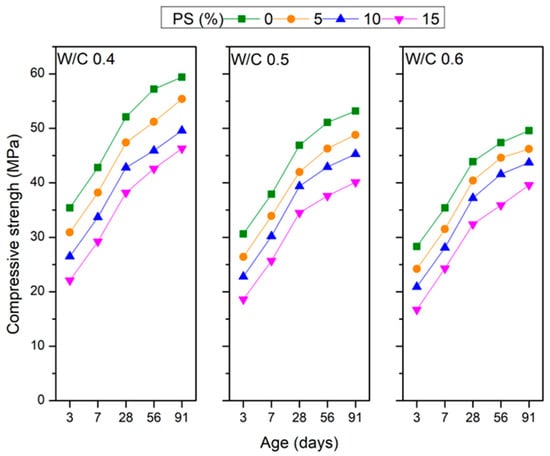
Figure 8.
Compressive strengths of cement mortars with different TPSW amounts at different ages.
Since the water absorption rate of the TPSW material was lower than that of natural sand and gravel, there were more water molecules in the mix, which led to the formation of additional pores, which, in turn, reduced the compressive strength. As shown in Figure 9, under different water–cement ratios (W/Cs), the compressive strength decreased linearly as the proportion of TPSW increased. The slopes of these three curves were nearly identical, indicating that the reduction in the compressive strength was independent of the W/C ratio, which is consistent with previous research findings [38].
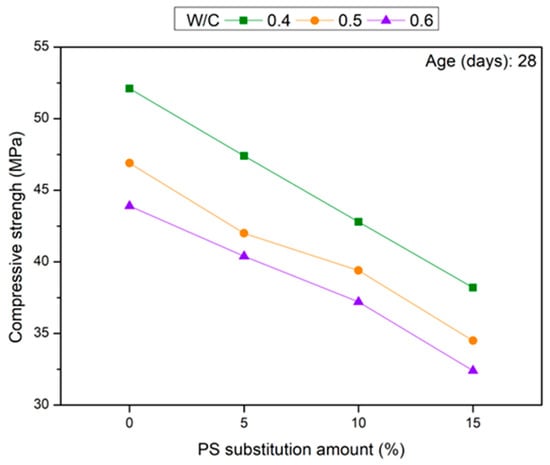
Figure 9.
Compressive strengths of cement mortars at 28 days with different W/C ratios and TPSW amounts.
3.5. Flexural Strength
Figure 10 illustrates the flexural strength development of the cement mortar made with varying replacement levels of the TPSW materials as partial sand substitutes under a fixed water-to-cement ratio of 0.5, with the control group serving as the baseline. At 3 days, the flexural strength of the control group was 10.4 MPa. For the 5% replacement, the strength was 9.5 MPa (−8.7%); for 10% replacement, it was 8.9 MPa (−14.4%); and for 15% replacement, it was 7.8 MPa (−25.0%). At 28 days, the flexural strength of the control group increased to 13.3 MPa. The 5% replacement group achieved 12.1 MPa (−9.0%), the 10% replacement group reached 10.8 MPa (−18.8%), and the 15% replacement group achieved 10.1 MPa (−24.1%). At 91 days, the control group achieved a flexural strength of 14.9 MPa, while the 5% replacement group reached 13.5 MPa (−9.4%), the 10% replacement group achieved 12.5 MPa (−16.1%), and the 15% replacement group recorded 11.5 MPa (−22.8%).

Figure 10.
Flexural strengths of cement mortars with different W/C ratios and TPSW amounts.
When the water-to-cement ratio was fixed at 0.5 and the curing period was extended to 91 days, a 5% replacement level resulted in a flexural strength reduction of only 9.4%. However, when the replacement level exceeded 10%, the strength reduction consistently surpassed 10%. These findings suggest that a 5% replacement level under these conditions was the most effective for utilizing waste materials, thus achieving the goal of recycling and reusing TPSW materials.
3.6. Ultrasonic Pulse Velocity
The effect of adding the TPSW to the concrete was evaluated using the ultrasonic pulse velocity (UPV), as shown in Figure 11. With a fixed water–cement ratio of 0.4, the ultrasonic velocity of the cement mortar ranged from 3788 m/s to 4630 m/s for the substitution amounts between 0% and 15%, measured over 3 to 28 days. At a water–cement ratio of 0.5, the velocity ranged from 3937 m/s to 4505 m/s, and at 0.6, it ranged from 3788 m/s to 4032 m/s. The results show that as the water–cement ratio decreased and the curing age increased, the UPV gradually rose. However, as the substitution amount of the TPSW increased, the UPV decreased, which reflected the impact on the mortar’s density.
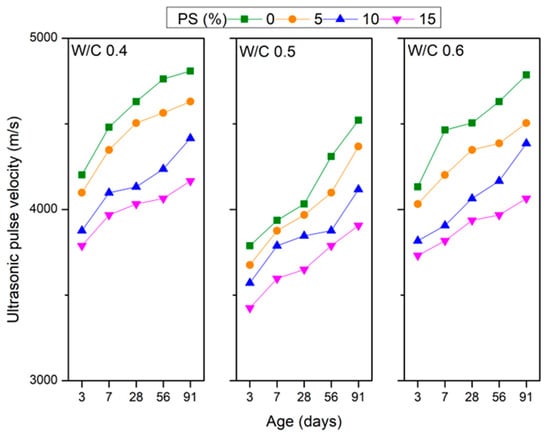
Figure 11.
Ultrasonic pulse velocities of cement mortars with different TPSW amounts at different ages.
Despite the decrease, within the studied substitution range, the UPV at 28 days reached 3650 m/s, indicating that the specimens retained good density and strength. As the TPSW content increased, more internal pores formed, which led to the reduction in UPV. In summary, lower water–cement ratios and longer curing periods resulted in higher UPV values, while an increased TPSW content tended to lower the UPV due to the reduced material density.
3.7. Water Absorption Rate
As shown in Figure 12, the effect of varying the replacement levels on the water absorption of cement mortar was analyzed under a fixed water-to-cement ratio of 0.5: At 3 days, the water absorption of the control group was 8.8%. For a 5% replacement, the absorption increased to 9.0% (+2.3% compared with the control group). At 10% replacement, it rose to 9.7% (+7.8% compared with 5%). At 15% replacement, the absorption reached 10.2% (+5.2% compared with 10%). At 91 days, the water absorption rates for the replacement levels of 0%, 5%, 10%, and 15% were 7.1%, 7.4%, 8.3%, and 8.5%, respectively. Compared with the control group, the increases were +4.2%, +16.9%, and +19.7% for 5%, 10%, and 15%, respectively.

Figure 12.
Water absorptions of cement mortars with different TPSW amounts at different ages.
The water absorption showed a decreasing trend with prolonged curing periods due to the completion of hydration reactions. In the early stages, incomplete hydration led to a higher porosity and a less dense structure, which resulted in higher absorption rates. By 28 days, the hydration reactions were more complete, which reduced the porosity and consequently lowered the water absorption. However, as the TPSW replacement level increased from 0% to 15%, the water absorption rose. This increase was attributed to the lower water absorption capacity of the TPSW compared with the natural sand, which caused excess water molecules in the mortar, which created more internal pores and ultimately increased the water absorption.
3.8. Resistance to Sulfate Attack
Figure 13 illustrates the weight loss rates of cement mortar samples with different replacement levels of TPSW material under a fixed water-to-cement ratio of 0.5: At 3 days, the weight loss rates for the replacement levels of 0%, 5%, 10%, and 15% were −8.4%, −7.5%, −6.9%, and −6.4%, respectively, with a 23.8% difference observed between the control group and the 15% replacement level. At 28 days, the weight loss rates decreased to −6.3%, −5.3%, −4.6%, and −4.3% for the same replacement levels, where the difference expanded to 31.7%. At 91 days, the corresponding weight loss rates were −4.9%, −4.7%, −3.9%, and −3.6%, with a 26.5% difference between the control group and the 15% replacement level.
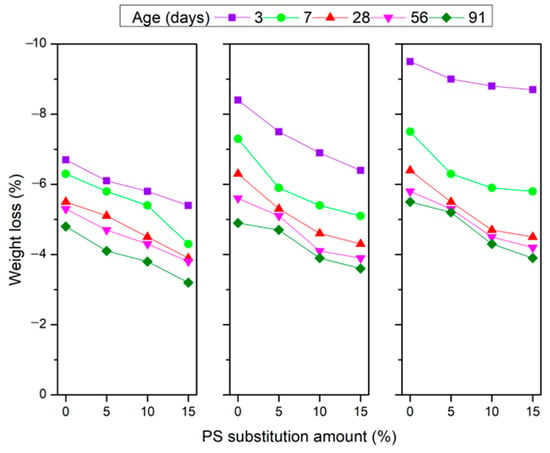
Figure 13.
Sulfate resistances of cement mortars with different TPSW amounts and W/C ratios.
As the replacement level of the TPSW material increased, the weight loss rate of the cement mortar consistently decreased across all the curing periods. This indicates an improvement in the resistance to environmental degradation. The decreased weight loss rate was attributed to the enhanced sulfate resistance of the TPSW material compared with natural sand. The inert nature of the TPSW material reduced the susceptibility of the mortar to sulfate attack, which led to less material degradation over time. The findings suggest that incorporating the TPSW material into the cement mortar can significantly improve its resistance to weight loss due to external chemical attacks. However, this benefit must be balanced against potential impacts on other mechanical properties to ensure optimal performance in practical applications. In conclusion, using the TPSW material as a sand replacement in the cement mortar not only enhanced the durability against sulfate attack but also contributed to sustainable waste management by recycling post-consumer plastics effectively.
3.9. Surface Resistivity
Figure 14 presents the results of a four-electrode resistivity analysis on the cement mortar samples produced with varying levels of the TPSW material as a partial sand replacement. This study was conducted at a fixed water-to-cement ratio of 0.5: At 3 days, the resistivity values for the replacement levels of 0%, 5%, 10%, and 15% were 8.1 kΩ-cm, 8.5 kΩ-cm, 8.9 kΩ-cm, and 9.2 kΩ-cm, respectively, with differences from the control group within 13.5%. At 28 days, the resistivity values increased to 11.2 kΩ-cm, 12.3 kΩ-cm, 13.5 kΩ-cm, and 14.2 kΩ-cm for the same replacement levels, where the differences expanded to within 26.8%. At 91 days, the resistivity values for the respective replacement levels reached 20.2 kΩ-cm, 22.3 kΩ-cm, 24.2 kΩ-cm, and 26.1 kΩ-cm.
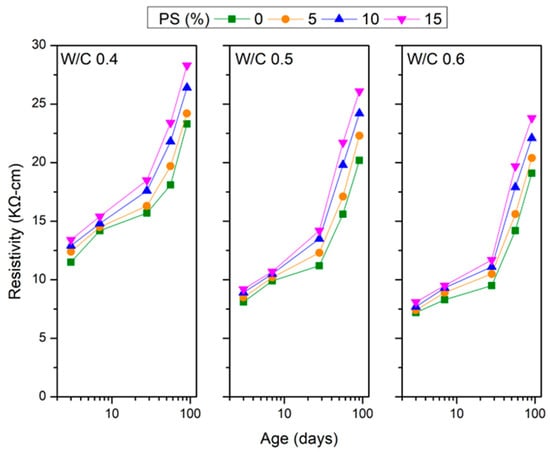
Figure 14.
Resistivities of the TPSW cement mortars with different W/C ratios at different ages.
The electrical resistivity of cement mortar increased with higher replacement levels of waste PS materials. At 91 days, all the samples exceeded 20 kΩ-cm, which met the durability benchmarks for resistance to ion penetration and environmental degradation. While the increased resistivity was desirable for durability, the trend was inversely correlated with the compressive strength and ultrasonic pulse velocity. This suggests that higher replacement levels, although beneficial for resistivity, could adversely affect the structural performance by increasing the porosity and reducing the material density. The enhanced resistivity indicates improved resistance to ionic migration, which is beneficial for long-term durability. However, the potential trade-offs in mechanical and structural performance must be carefully considered when optimizing the replacement levels for specific applications. Balancing durability with strength and integrity remains critical to achieving a sustainable and functional material design.
3.10. SEM Analysis
We utilized a scanning electron microscope (SEM) to observe the changes in the crystalline structure of the hydration product within the cement mortar, with a focus on the impact of the substitution amount of the TPSW.
For a water–cement ratios of 0.5 and a 5% replacement, the structural crystal image changes and pore distribution of the hydration products in the cement paste were observed using scanning electron microscopy (SEM) at 3 days and 91 days. In Figure 15, the observation results show that with the increase in the content of TPSW, the interfacial gap between the cement matrix and the plastic aggregate became larger, which weakened the adhesion of the matrix. Furthermore, the addition of the discarded TV casings resulted in the enlargement of the bubbles and an increase in the number of pores formed in the internal structure. At the age of 3 days, since the material had not yet completed the hydration reaction, the formation rate of the hydration products was slow, which resulted in more obvious pores and cracks in the matrix, which was particularly significant compared with the control group. However, when the age was extended to 91 days, the hydration products gradually filled the internal pores, which significantly reduced the number of pores, which made the structure denser and improved the overall performance of the matrix.
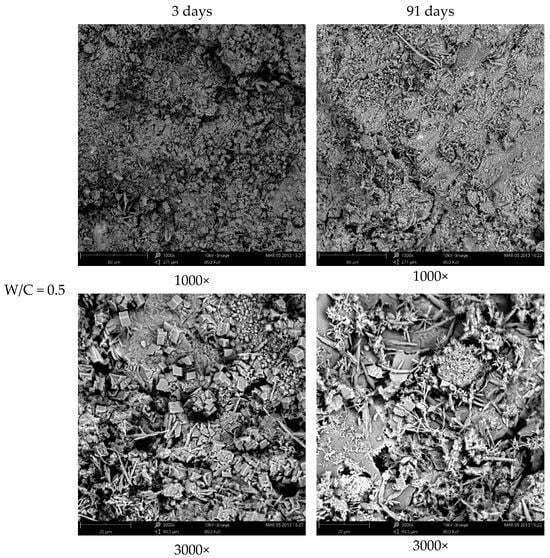
Figure 15.
SEM images of 5% TPSW cement mortar at different ages.
4. Conclusions
- The slump and slump flow of the cement mortar made by replacing sand with the TPSW decreased as the amount of TPSW added increased. Since the TPSW was less smooth than natural sand, the slump and slump flow were reduced. When the W/C increased, the slump and slump flow increased due to the increase in the water content. When the setting time was prolonged, the W/C ratio had a greater impact than the substitution amount.
- The compressive strength decreased as the amount of TPSW substitution increased because the waste PS was less water-absorbent than natural sand during mixing, which resulted in more water molecules. The cementing ability was degraded and pores were formed. A W/C of 0.5 and a TPSW substitution amount of 5% could effectively achieve the economic benefits of waste recycling.
- As the amount of TPSW added increased, the flexural strength decreased. When the W/C was 0.5 and at the age of 91 days, the strength was reduced by 9.4% when the substitution amount was 5%. When the substitution amount exceeded 10%, the strength was reduced by more than 10%, showing that a W/C of 0.5 and a TPSW substitution amount of 5% were the most effective at removing waste for waste recycling.
- Since the ultrasonic pulse velocity depends on the internal density of the specimen, when the W/C was 0.4 and the TPSW substitution amount was 5% at the age of 56 days, the ultrasonic pulse velocity was greater than 4500 m/s, indicating that the specimen quality was good. As the substitution amount and W/C increased, pores were formed inside, so the ultrasonic pulse velocity decreased. The velocity increased with age.
- As the W/C and the waste PS substitution amount increased, the number of pores in the specimen increased, and the number of internal pores increased; at later ages, the water absorption distinctly decreased. The water absorption had a relative relationship with the ultrasound and strength. The higher the ultrasonic pulse velocity was, the denser the specimen, the lower the water absorption, and the greater the strength.
- The weight loss results for the cement mortar show that the W/C ratio had a greater impact than the substitution amount. The weight loss increased with the W/C. As the substitution amount increased and as the sulfate resistance of the TPSW became greater than that of the natural sand, the weight loss tended to decrease. The weight loss was greater at an early age. The hydration was relatively complete at late ages, so the weight loss of the specimen tended to decrease.
- The resistivity decreased as the W/C increased. Since the TPSW had a higher resistivity than natural sand, the resistivity increased with the substitution amount and age.
Author Contributions
Conceptualization, H.-Y.W.; Methodology, C.-H.W. and S.-L.T.; Formal analysis, C.-C.H.; Investigation, C.-F.L.; Resources, H.-Y.W.; Data curation, C.-C.W.; Writing–review & editing, C.-C.H. and H.-Y.W. All authors have read and agreed to the published version of the manuscript.
Funding
This research received no external funding.
Institutional Review Board Statement
Not applicable.
Informed Consent Statement
Not applicable.
Data Availability Statement
Data is contained within the article.
Conflicts of Interest
First author Chang-chi Hung was employed by the Hoei Construction Co., Ltd., Taiwan. The research was conducted in the absence of any commercial or financial relationships that could be construed as a potential conflict of interest.
References
- Wang, P.-K.; Lin, J.-Y.; Yang, C.-P.; Cheng, T.-M. The Island Habitat: Environmental Survey Report of Taiwan. Rhythms Monthly; Tzu Chi Culture & Communication Foundation: Taipei, Taiwan, 2007. [Google Scholar]
- Wen, F.-L. Study on Engineering Properties of Cement Mortar with Adding and Cement Replacement by PE and GGBFS. Master’s Thesis, National Kaohsiung University of Science and Technology, Kaohsiung, Taiwan, 2022. [Google Scholar]
- Rasmussen, S.C. From parkesine to celluloid: The birth of organic plastics. Angew. Chem. 2021, 133, 8090–8094. [Google Scholar] [CrossRef]
- Revathi, S.; Suresh, D.; Anwar, S.T. Behavior of concrete with PET bottles as fibers & silica fume as partial replacement of cement. Mater. Today Proc. 2023. [Google Scholar] [CrossRef]
- Jassim, A.K. Recycling of polyethylene waste to produce plastic cement. Procedia Manuf. 2017, 8, 635–642. [Google Scholar] [CrossRef]
- Lin, J.-W. Study on Engineering Properties of Cement Mortar with Adding Abandoned PE. Master’s Thesis, National Kaohsiung University of Science and Technology, Kaohsiung, Taiwan, 2022. [Google Scholar]
- El-Seidy, E.; Chougan, M.; Sambucci, M.; Al-Kheetan, M.J.; Valente, M.; Ghaffar, S.H. Lightweight alkali-activated materials and ordinary Portland cement composites using recycled polyvinyl chloride and waste glass aggregates to fully replace natural sand. Constr. Build. Mater. 2023, 368, 130399. [Google Scholar] [CrossRef]
- Małek, M.; Jackowski, M.; Łasica, W.; Kadela, M. Characteristics of recycled polypropylene fibers as an addition to concrete fabrication based on Portland cement. Materials 2020, 13, 1827. [Google Scholar] [CrossRef]
- Gregorova, V.; Ledererova, M.; Stefunkova, Z. Investigation of influence of recycled plastics from cable, ethylene vinyl acetate and polystyrene waste on lightweight concrete properties. Procedia Eng. 2017, 195, 127–133. [Google Scholar] [CrossRef]
- Olofinnade, O.; Chandra, S.; Chakraborty, P. Recycling of high impact polystyrene and low-density polyethylene plastic wastes in lightweight based concrete for sustainable construction. Mater. Today Proc. 2021, 38, 2151–2156. [Google Scholar] [CrossRef]
- Akinyemi, B.A.; Ojediran, J.; Olawale, O.; Ayanwola, S. Efficacy of expanded polystyrene as fine aggregate in cement mortars modified with latex paint as an alternative to polymer admixture. J. Mech. Behav. Mater. 2020, 29, 163–168. [Google Scholar] [CrossRef]
- Al-Mansour, A.; Chen, S.; Xu, C.; Peng, Y.; Wang, J.; Ruan, S.; Zeng, Q. Sustainable cement mortar with recycled plastics enabled by the matrix-aggregate compatibility improvement. Constr. Build. Mater. 2022, 318, 125994. [Google Scholar] [CrossRef]
- Ohemeng, E.A.; Ekolu, S.O. Strength prediction model for cement mortar made with waste LDPE plastic as fine aggregate. J. Sustain. Cem.-Based Mater. 2019, 8, 228–243. [Google Scholar] [CrossRef]
- Hung, C.-C.; Chang, J.-N.; Wang, H.-Y.; Wen, F.-L. Effect of adding waste polyethylene and GGBFS on the engineering properties of cement mortar. Appl. Sci. 2022, 12, 12665. [Google Scholar] [CrossRef]
- Lin, K.-T.; Hung, C.-C.; Wang, H.-Y.; Wen, F.-L. Polyethylene (PE) Waste Minimization Study of Cement Mortar with Adding PE Content under Different W/B Ratios. Buildings 2022, 12, 2117. [Google Scholar] [CrossRef]
- Doughmi, K.; Baba, K.; Nounah, A. Mechanical properties of eco-friendly cement based composite mortars plastic fiber reinforced partially replaced by natural pozzolan and marble waste. Mater. Today Proc. 2023, in press. [Google Scholar] [CrossRef]
- Ferrándiz-Mas, V.; García-Alcocel, E. Durability of expanded polystyrene mortars. Constr. Build. Mater. 2013, 46, 175–182. [Google Scholar] [CrossRef]
- Ferrándiz-Mas, V.; Sarabia, L.A.; Ortiz, M.C.; Cheeseman, C.R.; García-Alcocel, E. Design of bespoke lightweight cement mortars containing waste expanded polystyrene by experimental statistical methods. Mater. Des. 2016, 89, 901–912. [Google Scholar] [CrossRef]
- Koksal, F.; Mutluay, E.; Gencel, O. Characteristics of isolation mortars produced with expanded vermiculite and waste expanded polystyrene. Constr. Build. Mater. 2020, 236, 117789. [Google Scholar] [CrossRef]
- Petrella, A.; Di Mundo, R.; Notarnicola, M. Recycled expanded polystyrene as lightweight aggregate for environmentally sustainable cement conglomerates. Materials 2020, 13, 988. [Google Scholar] [CrossRef]
- Maaroufi, M.; Belarbi, R.; Abahri, K.; Benmahiddine, F. Full characterization of hygrothermal, mechanical and morphological properties of a recycled expanded polystyrene-based mortar. Constr. Build. Mater. 2021, 301, 124310. [Google Scholar] [CrossRef]
- Qin, Y.; Dong, L.; Lu, H.; Zhan, L.; Xu, Z. Debromination process of Br-containing PS of E-wastes and reuse with virgin PS. J. Hazard. Mater. 2022, 431, 128526. [Google Scholar] [CrossRef]
- Chen, J.H. Study on Engineering Properties of Ready-Mixed Soil Material with Applied of Recycled Materials. Master’s Thesis, National Kaohsiung University of Applied Sciences, Kaohsiung, Taiwan, 2012. [Google Scholar]
- Jhou, J.-W. Investigating the Properties of Lightweight Concrete Containing High Contents of Recycled Green Building Materials. Master’s Thesis, National Kaohsiung University of Applied Sciences, Kaohsiung, Taiwan, 2013. [Google Scholar]
- Chang, S.-C. A Study of Engineering Properties and Prediction Models Development for Cement Mortar added with Recycled Materials and Piezoelectric Powders. Master’s Thesis, National Kaohsiung University of Applied Sciences, Kaohsiung, Taiwan, 2016. [Google Scholar]
- Ay, H.; Wang, H.-Y.; Huan, C.-F.; Lin, X.-H. The application of energy-saving and carbon-reducing materials in public engineering projects. In Energy-Saving and Carbon Reduction Training and Promotion; Kaohsiung, Taiwan, 2011. [Google Scholar]
- Lou, B.; Shen, H.; Liu, B.; Liu, J.; Zhang, S. Recycling secondary aluminum dross to make building materials: A review. Constr. Build. Mater. 2023, 409, 133989. [Google Scholar] [CrossRef]
- John, N.J.; Khan, I.; Patel, A. Evaluation of the crushing characteristics of industrial waste aggregates as construction materials. Constr. Build. Mater. 2023, 403, 133111. [Google Scholar] [CrossRef]
- Deng, J.; Guo, J.; Zhou, X.; Zhou, P.; Fu, X.; Zhang, W.; Lin, K. Hazardous substances in indoor dust emitted from waste TV recycling facility. Environ. Sci. Pollut. Res. 2014, 21, 7656–7667. [Google Scholar] [CrossRef] [PubMed]
- Xiao, S.; Dong, H.; Geng, Y.; Brander, M. An overview of China’s recyclable waste recycling and recommendations for integrated solutions. Resour. Conserv. Recycl. 2018, 134, 112–120. [Google Scholar] [CrossRef]
- Matsuto, T.; Jung, C.H.; Tanaka, N. Material and heavy metal balance in a recycling facility for home electrical appliances. Waste Manag. 2004, 24, 425–436. [Google Scholar] [CrossRef]
- Bederina, M.; Marmoret, L.; Mezreb, K.; Khenfer, M.; Bali, A.; Quéneudec, M. Effect of the addition of wood shavings on thermal conductivity of sand concretes: Experimental study and modeling. Constr. Build. Mater. 2007, 21, 662–668. [Google Scholar] [CrossRef]
- Wang, R.; Zhang, T.; Wang, P. Waste printed circuit boards nonmetallic powder as admixture in cement mortar. Mater. Struct. 2012, 45, 1439–1445. [Google Scholar] [CrossRef]
- Nematchoua, M.K.; Tchinda, R.; Orosa, J.A.; Andreasi, W.A. Effect of wall construction materials over indoor air quality in humid and hot climate. J. Build. Eng. 2015, 3, 16–23. [Google Scholar] [CrossRef]
- Jang, H.S.; So, S.Y. The properties of cement-based mortar using different particle size of grinding waste insulator powder. J. Build. Eng. 2015, 3, 48–57. [Google Scholar] [CrossRef]
- de Brito, J.; Ferreira, J.; Pacheco, J.; Soares, D.; Guerreiro, M. Structural, material, mechanical and durability properties and behavior of recycled aggregates concrete. J. Build. Eng. 2016, 6, 1–16. [Google Scholar] [CrossRef]
- Wang, R.; Meyer, C. Performance of cement mortar made with recycled high impact polystyrene. Cem. Concr. Compos. 2012, 34, 975–981. [Google Scholar] [CrossRef]
- Senthil Kumar, K.; Baskar, K. Development of ecofriendly concrete incorporating recycled high-impact polystyrene from hazardous electronic waste. J. Hazard. Toxic Radioact. Waste 2015, 19, 04014042. [Google Scholar] [CrossRef]
- Aocharoen, Y.; Chotickai, P. Compressive mechanical properties of cement mortar containing recycled high-density polyethylene aggregates: Stress–strain relationship. Case Stud. Constr. Mater. 2021, 15, e00752. [Google Scholar] [CrossRef]
- Pacheco-Torgal, F.; Ding, Y.; Jalali, S. Properties and durability of concrete containing polymeric wastes (tyre rubber and polyethylene terephthalate bottles): An overview. Constr. Build. Mater. 2012, 30, 714–724. [Google Scholar] [CrossRef]
- Sharma, R.; Bansal, P.P. Use of different forms of waste plastic in concrete—A review. J. Clean. Prod. 2016, 112, 473–482. [Google Scholar] [CrossRef]
- Siddique, R.; Khatib, J.; Kaur, I. Use of recycled plastic in concrete: A review. Waste Manag. 2008, 28, 1835–1852. [Google Scholar] [CrossRef]
- Babafemi, A.J.; Šavija, B.; Paul, S.C.; Anggraini, V. Engineering properties of concrete with waste recycled plastic: A review. Sustainability 2018, 10, 3875. [Google Scholar] [CrossRef]
- Alkhrissat, T. Impact of adding waste polyethylene (PE) and silica fume (SF) on the engineering properties of cement mortar. Case Stud. Chem. Environ. Eng. 2024, 9, 100731. [Google Scholar] [CrossRef]
- ASTM C150 specification; Standard Specification for Portland Cement, Page Count: 8. American Society for Testing and Materials: Philadelphia, PA, USA, 2012. [CrossRef]
- CNS 487 specification; Method of Test for Density, Relative Density (Specific Gravity), and Absorption of Fine Aggregate, Page Count: 9. Chinese National Standards: Taiwan, China, 2013.
- ASTM C109 specification; Standard Test Method for Compressive Strength of Hydraulic Cement Mortars (Using 2-in. or 50 mm Cube Specimens), Page Count: 11. American Society for Testing and Materials: Philadelphia, PA, USA, 1994. [CrossRef]
- ASTM C230 specification; Standard Specification for Flow Table for Use in Tests of Hydraulic Cement, Page Count: 7. American Society for Testing and Materials: Philadelphia, PA, USA, 2021. [CrossRef]
- ASTM C403 specification; Standard Test Method for Time of Setting of Concrete Mixtures by Penetration Resistance, Page Count: 7. American Society for Testing and Materials: Philadelphia, PA, USA, 2017. [CrossRef]
- ASTM C348 specification; Standard Test Method for Flexural Strength of Hydraulic Cement Mortars, Page Count: 6. American Society for Testing and Materials: Philadelphia, PA, USA, 2021. [CrossRef]
- ASTM C597 specification; Standard Test Method for Pulse Velocity Through Concrete, Page Count: 4. American Society for Testing and Materials: Philadelphia, PA, USA, 2016. [CrossRef]
- ASTM C1585 specification; Standard Test Method for Measurement of the Rate of Absorption of Water by Hydraulic-Cement Concretes, Page Count: 6. American Society for Testing and Materials: Philadelphia, PA, USA, 2020. [CrossRef]
- ASTM C1012 specification; Standard Test Method for Length Change of Hydraulic-Cement Mortars Exposed to a Sulfate Solution, Page Count: 9. American Society for Testing and Materials: Philadelphia, PA, USA, 2024. [CrossRef]
- ASTM C876 specification; Standard Test Method for Corrosion Potentials of Uncoated Reinforcing Steel in Concrete, Page Count: 8. American Society for Testing and Materials: Philadelphia, PA, USA, 2015. [CrossRef]
Disclaimer/Publisher’s Note: The statements, opinions and data contained in all publications are solely those of the individual author(s) and contributor(s) and not of MDPI and/or the editor(s). MDPI and/or the editor(s) disclaim responsibility for any injury to people or property resulting from any ideas, methods, instructions or products referred to in the content. |
© 2025 by the authors. Licensee MDPI, Basel, Switzerland. This article is an open access article distributed under the terms and conditions of the Creative Commons Attribution (CC BY) license (https://creativecommons.org/licenses/by/4.0/).